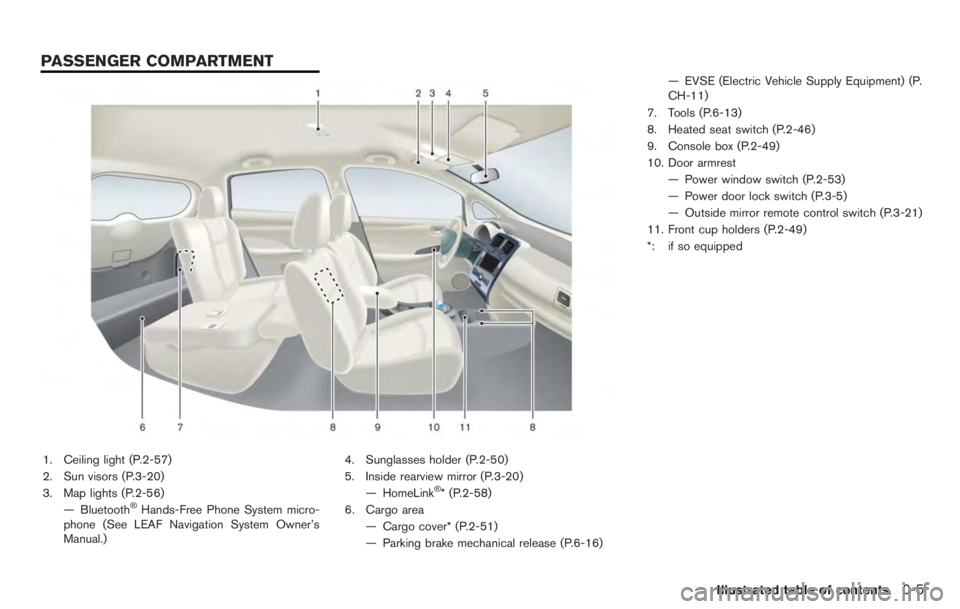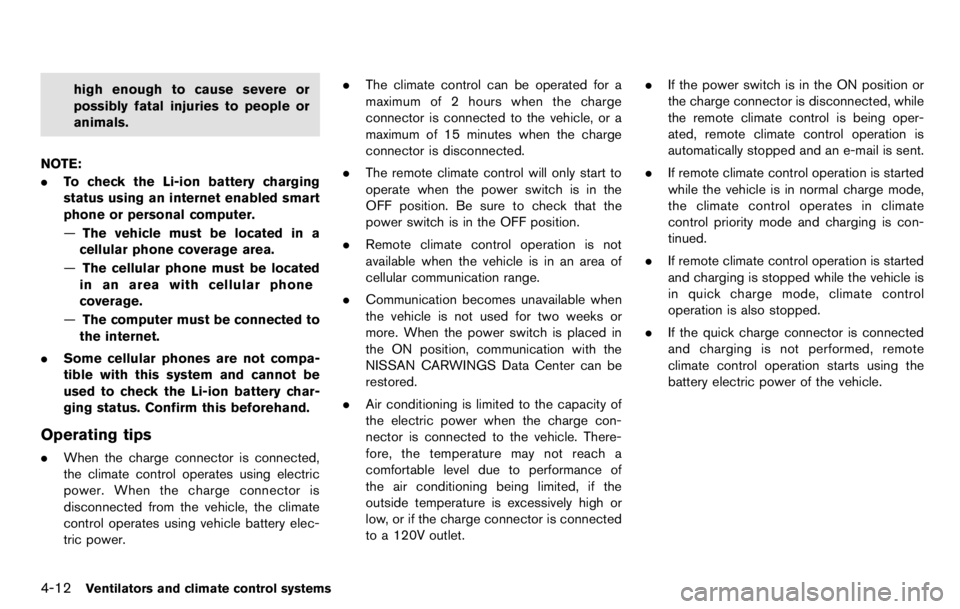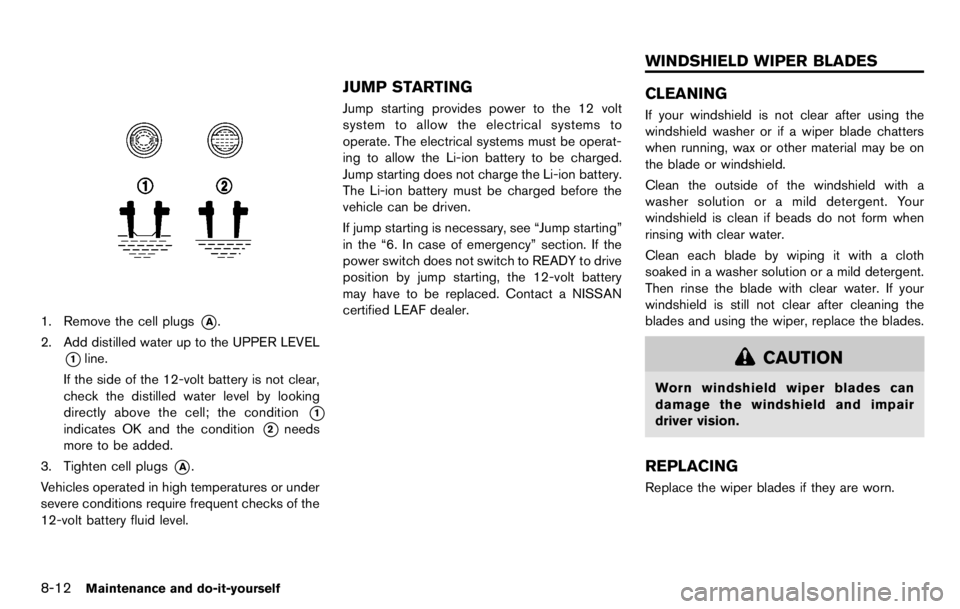change time NISSAN LEAF 2012 Owners Manual
[x] Cancel search | Manufacturer: NISSAN, Model Year: 2012, Model line: LEAF, Model: NISSAN LEAF 2012Pages: 1062, PDF Size: 3.63 MB
Page 11 of 1062

.While the battery is being charged, the
Climate Ctrl. Timer cannot be operated until
the Li-ion battery available charge gauge
reached the full mark. When the battery is
not being charged, the Climate Ctrl. Timer
can be operated, even if the Li-ion battery
available charge gauge has not reached the
full mark.
. When the climate control is set on first
priority, the Climate Ctrl. Timer works
regardless of the remaining battery energy.
. If the Climate Ctrl. Timer starts its operation
while the vehicle is being charged, the
charging time will be prolonged.
. Operating the Climate Ctrl. Timer or remote
climate control in an environment with low
temperature may decrease the rate of
battery charge.
. The Climate Ctrl. Timer settings cannot be
modified while it is operating. If timer
settings are modified while the Climate Ctrl.
Timer is operating, these changes will be
reflected the next time the Climate Ctrl.
Timer operates.
. When charging is set as the first priority, the
Climate Ctrl. Timer does not start until 10
segments of the LI-ION BATTERY AVAIL-
ABLE CHARGE GAUGE are illuminated. .
When the climate control is set as the first
priority, the climate control system will be
turned on as scheduled by the Climate Ctrl.
Timer regardless of the remaining battery
energy.
. Even when the climate control is set as the
first priority, the climate control system will
be turned off when the climate control
spends more electric than the charging Li-
ion battery.
. The Li-ion battery may not charge or may
even become discharged if the Climate Ctrl.
Timer or remote climate control is used in
low ambient temperatures.
REMOTE CLIMATE CONTROL
This vehicle incorporates a communication
device that is called a TCU (Telematics Com-
munication Unit). The communication connec-
tion between this unit and NISSAN CARWINGS
Data Center allows for various remote function
services.
Even when away from the vehicle, climate
control can be started by accessing the
NISSAN CARWINGS Data Center website
using a cellular phone or a personal computer.
When operation is started, or at the set start
time, the NISSAN CARWINGS Data Center accesses the vehicle. When the vehicle receives
a command for remote operation, the climate
control immediately turns ON and operates for
the specified period of time. Confirmation of the
ON/OFF of the climate control operation can be
checked by accessing the website or by e-mail.
Establishing the CARWINGS
TMservice is ne-
cessary before using the service. See LEAF
Navigation System Owner’s Manual.
Page 18 of 1062

.Do not place metalized film or any
metal parts (antenna, etc.) on the
windows. This may cause poor re-
ception of the signals from the tire
pressure sensors, and the TPMS will
not function properly.
Some devices and transmitters may temporarily
interfere with the operation of the TPMS and
cause the low tire pressure warning light to
illuminate. Some examples are:
. Facilities or electric devices using similar
radio frequencies that are near the vehicle.
. If a transmitter set to similar frequencies is
being used in or near the vehicle.
. If a computer (or similar equipment) or a DC/
AC converter is being used in or near the
vehicle.
FCC Notice:
For USA:
This device complies with Part 15 of the
FCC Rules. Operation is subject to the
following two conditions: (1) This device
may not cause harmful interference, and
(2) this device must accept any interfer-
ence received, including interference that
may cause undesired operation. NOTE:
Changes or modifications not expressly
approved by the party responsible for
compliance could void the user’s authority
to operate the equipment.
For Canada:
This device complies with RSS-210 of
Industry Canada. Operation is subject to
the following two conditions: (1) this
device may not cause interference, and
(2) this device must accept any interfer-
ence, including interference that may
cause undesired operation of the device.
TPMS with Easy Fill Tire Alert
When tire pressure is low, the low tire pressure
warning light illuminates.
This vehicle provides visual and audible signals
to help you inflate the tires to the recommended
COLD tire pressure.
Vehicle set-up:
1. Park the vehicle in a safe and level place.
2. Apply the parking brake and push the P
position switch on the selector lever.
3. Place the power switch in the ON position. Do not place in the READY to drive mode. Operation:
1. Add air to the tire.
2. After a few seconds, the hazard indicators
will start flashing.
3. When the designated pressure is reached, the horn beeps once and the hazard
indicators stop flashing.
4. Perform the above steps for each tire.
. If the tire is over-inflated more than approxi-
mately 4 psi (30 kPa), the horn beeps and
the hazard indicators flash 3 times. To
correct the pressure, push the core of the
valve stem on the tire briefly to release
pressure. When the pressure reaches the
designated pressure, the horn beeps once.
. If the hazard indicator does not flash within
approximately 15 seconds after starting to
inflate the tire, it indicates that the Easy Fill
Tire Alert is not operating.
. The TPMS will not activate the Easy Fill Tire
Alert under the following conditions:
— If there is interference from an external
device or transmitter.
— The air pressure from the inflation device is not sufficient to inflate the tire such as
those using a power socket.
Page 148 of 1062

webbing for cuts, fraying, wear or damage.
Steering wheel:Check for changes in the
steering conditions, such as excessive free play,
hard steering or strange noises.
Warning lights and chimes: Make sure that
all warning lights and chimes are operating
properly.
Windshield defroster: Check that the air
emits from the defroster outlets properly and in
sufficient quantity when operating the heater or
air conditioner.
Windshield wiper and washer*: Check that
the wipers and washers operate properly and
that the wipers do not streak.
Under hood and vehicle
The maintenance items listed here should be
checked periodically.
12-volt battery*: Check the fluid level in each
cell.
It should be between the MAX and MIN lines.
Vehicles operated in high temperatures or under
severe conditions require frequent checks of the
12-volt battery fluid level.
Brake fluid level*: Make sure that the brake
fluid level is between the MAX and MIN lines on
the reservoir. Coolant level*:
Check the coolant level when
the motor compartment is cold.
Fluid leaks: Check under the vehicle for water
or other fluid leaks after the vehicle has been
parked for a short period of time. Water dripping
from the air conditioner after use is normal. If you
notice any leaks, check for the cause and have it
corrected immediately.
Radiator and hoses: Check the front of the
radiator and clean off any dirt, insects, leaves,
etc., that may have accumulated. Make sure that
the hoses have no cracks, deformation, rot or
loose connections.
Underbody: The underbody is frequently ex-
posed to corrosive substances such as those
used on icy roads or to control dust. It is very
important to remove these substances, other-
wise rust will form on the floor pan and frame. At
the end of winter, the underbody should be
thoroughly flushed with plain water, being care-
ful to clean those areas where mud and dirt may
accumulate. For additional information, see
“Cleaning exterior” in the “7. Appearance and
care” section.
Windshield washer fluid*: Check that there is
an adequate amount of fluid in the reservoir.
Page 191 of 1062

WARNING
.Every person who drives or rides in
this vehicle should use a seat belt at
all times. Children should be prop-
erly restrained in the rear seat and,
if appropriate, in a child restraint.
. The seat belt should be properly
adjusted to a snug fit. Failure to do
so may reduce the effectiveness of
the entire restraint system and in-
crease the chance or severity of
injury in an accident. Serious injury
or death can occur if the seat belt is
not worn properly.
. Always route the shoulder belt over
your shoulder and across your
chest. Never put the belt behind
your back, under your arm or across
your neck. The belt should be away
from your face and neck, but not
falling off your shoulder.
. Position the lap belt as low and
snug as possible AROUND THE
HIPS, NOT THE WAIST. A lap belt
worn too high could increase the
risk of internal injuries in an acci-
dent. .
Be sure the seat belt tongue is
securely fastened to the proper
buckle.
. Do not wear the seat belt inside out
or twisted. Doing so may reduce its
effectiveness.
. Do not allow more than one person
to use the same seat belt.
. Never carry more people in the
vehicle than there are seat belts.
. If the seat belt warning light glows
continuously while the power switch
is turned ON with all doors closed
and all seat belts fastened, it may
indicate a malfunction in the sys-
tem. Have the system checked by a
NISSAN certified LEAF dealer.
. No changes should be made to the
seat belt system. For example, do
not modify the seat belt, add mate-
rial, or install devices that may
change the seat belt routing or
tension. Doing so may affect the
operation of the seat belt system.
Modifying or tampering with the
seat belt system may result in
serious personal injury.
Safety—Seats, seat belts and supplemental restraint system1-11
Page 233 of 1062

CHARGING THE 12-VOLT BATTERY
The 12-volt battery is charged automatically
using electricity stored in the Li-ion battery.
When the 12-volt battery is being charged, the
charge status indicator light on the instrument
panel flashes. (except when charging the Li-ion
battery or the power switch is in the READY to
drive position.) See “Charging status indicator
lights” in the “CH. Charging” section.
While vehicle is in use
The Li-ion battery charges the 12-volt battery as
necessary when the power switch is in the
READY to drive position or ON position.
The 12-volt battery is not charged in the
following conditions.
.When the power switch is in ACC position.
. When the power switch is in ON position
and shift position is in the N (Neutal)
position.
While the vehicle is not in use
When the EV (Electric Vehicle) system is off for
an extended time, the 12-volt battery may be
automatically charged for a short period of time
on a regular basis.
LI-ION BATTERY HEATER
CAUTION
The Li-ion battery heater does not
operate if the available Li-ion battery
charge is less than approximately 30%
and the charger is not connected to the
vehicle. To help prevent the Li-ion
battery from freezing, do not leave the
vehicle in an environment if tempera-
tures may go below -48F (-208C) unless
the vehicle is connected to a charger.
The Li-ion battery heater helps to prevent the Li-
ion battery from freezing and helps to prevent
significant reductions in the Li-ion battery output
when the temperature is cold. The Li-ion battery
heater automatically turns on when the Li-ion
battery temperature is approximately -48 F
(-208C) or colder. The Li-ion battery heater
automatically turns off when the Li-ion battery
temperture is approximately 148F (-108C) or
higher.
The Li-ion battery heater uses electrical power
from an external source when a charger is
connected to the vehicle. The Li-ion battery
heater uses electrical power from the Li-ion
battery when the charger is not connected to the vehicle.
NOTE:
.
Connect the charger to the vehicle and
place the power switch in the OFF
position when parking the vehicle if
temperatures may go below -48 F
(-208C) . This provides external power
to the Li-ion battery heater when it
operates and does not discharge the
Li-ion battery.
. The charging status indicator lights
illuminate in a specific pattern when
the Li-ion battery heater operates. The
charging status indicator lights use the
same pattern to indicate 12-volt battery
charging, Climate Ctrl. Timer operation
or Remote Climate Control operation.
The charging status indicator lights do
not change if the Li-ion battery heater
operates at the same time as the above
features. See “Charging status indica-
tor lights” in the “CH. Charging” sec-
tion.
. The Li-ion battery heater uses Li-ion
battery power to operate, even if the
vehicle is connected to a charger when:
EV OverviewEV-5
Page 301 of 1062

WARNING
.Every person who drives or rides in
this vehicle should use a seat belt at
all times. Children should be prop-
erly restrained in the rear seat and,
if appropriate, in a child restraint.
. The seat belt should be properly
adjusted to a snug fit. Failure to do
so may reduce the effectiveness of
the entire restraint system and in-
crease the chance or severity of
injury in an accident. Serious injury
or death can occur if the seat belt is
not worn properly.
. Always route the shoulder belt over
your shoulder and across your
chest. Never put the belt behind
your back, under your arm or across
your neck. The belt should be away
from your face and neck, but not
falling off your shoulder.
. Position the lap belt as low and
snug as possible AROUND THE
HIPS, NOT THE WAIST. A lap belt
worn too high could increase the
risk of internal injuries in an acci-
dent. .
Be sure the seat belt tongue is
securely fastened to the proper
buckle.
. Do not wear the seat belt inside out
or twisted. Doing so may reduce its
effectiveness.
. Do not allow more than one person
to use the same seat belt.
. Never carry more people in the
vehicle than there are seat belts.
. If the seat belt warning light glows
continuously while the power switch
is turned ON with all doors closed
and all seat belts fastened, it may
indicate a malfunction in the sys-
tem. Have the system checked by a
NISSAN certified LEAF dealer.
. No changes should be made to the
seat belt system. For example, do
not modify the seat belt, add mate-
rial, or install devices that may
change the seat belt routing or
tension. Doing so may affect the
operation of the seat belt system.
Modifying or tampering with the
seat belt system may result in
serious personal injury.
Safety—Seats, seat belts and supplemental restraint system1-11
Page 367 of 1062

.While the battery is being charged, the
Climate Ctrl. Timer cannot be operated until
the Li-ion battery available charge gauge
reached the full mark. When the battery is
not being charged, the Climate Ctrl. Timer
can be operated, even if the Li-ion battery
available charge gauge has not reached the
full mark.
. When the climate control is set on first
priority, the Climate Ctrl. Timer works
regardless of the remaining battery energy.
. If the Climate Ctrl. Timer starts its operation
while the vehicle is being charged, the
charging time will be prolonged.
. Operating the Climate Ctrl. Timer or remote
climate control in an environment with low
temperature may decrease the rate of
battery charge.
. The Climate Ctrl. Timer settings cannot be
modified while it is operating. If timer
settings are modified while the Climate Ctrl.
Timer is operating, these changes will be
reflected the next time the Climate Ctrl.
Timer operates.
. When charging is set as the first priority, the
Climate Ctrl. Timer does not start until 10
segments of the LI-ION BATTERY AVAIL-
ABLE CHARGE GAUGE are illuminated. .
When the climate control is set as the first
priority, the climate control system will be
turned on as scheduled by the Climate Ctrl.
Timer regardless of the remaining battery
energy.
. Even when the climate control is set as the
first priority, the climate control system will
be turned off when the climate control
spends more electric than the charging Li-
ion battery.
. The Li-ion battery may not charge or may
even become discharged if the Climate Ctrl.
Timer or remote climate control is used in
low ambient temperatures.
REMOTE CLIMATE CONTROL
This vehicle incorporates a communication
device that is called a TCU (Telematics Com-
munication Unit). The communication connec-
tion between this unit and NISSAN CARWINGS
Data Center allows for various remote function
services.
Even when away from the vehicle, climate
control can be started by accessing the
NISSAN CARWINGS Data Center website
using a cellular phone or a personal computer.
When operation is started, or at the set start
time, the NISSAN CARWINGS Data Center accesses the vehicle. When the vehicle receives
a command for remote operation, the climate
control immediately turns ON and operates for
the specified period of time. Confirmation of the
ON/OFF of the climate control operation can be
checked by accessing the website or by e-mail.
Establishing the CARWINGS
TMservice is ne-
cessary before using the service. See LEAF
Navigation System Owner’s Manual.
Page 374 of 1062

.Do not place metalized film or any
metal parts (antenna, etc.) on the
windows. This may cause poor re-
ception of the signals from the tire
pressure sensors, and the TPMS will
not function properly.
Some devices and transmitters may temporarily
interfere with the operation of the TPMS and
cause the low tire pressure warning light to
illuminate. Some examples are:
. Facilities or electric devices using similar
radio frequencies that are near the vehicle.
. If a transmitter set to similar frequencies is
being used in or near the vehicle.
. If a computer (or similar equipment) or a DC/
AC converter is being used in or near the
vehicle.
FCC Notice:
For USA:
This device complies with Part 15 of the
FCC Rules. Operation is subject to the
following two conditions: (1) This device
may not cause harmful interference, and
(2) this device must accept any interfer-
ence received, including interference that
may cause undesired operation. NOTE:
Changes or modifications not expressly
approved by the party responsible for
compliance could void the user’s authority
to operate the equipment.
For Canada:
This device complies with RSS-210 of
Industry Canada. Operation is subject to
the following two conditions: (1) this
device may not cause interference, and
(2) this device must accept any interfer-
ence, including interference that may
cause undesired operation of the device.
TPMS with Easy Fill Tire Alert
When tire pressure is low, the low tire pressure
warning light illuminates.
This vehicle provides visual and audible signals
to help you inflate the tires to the recommended
COLD tire pressure.
Vehicle set-up:
1. Park the vehicle in a safe and level place.
2. Apply the parking brake and push the P
position switch on the selector lever.
3. Place the power switch in the ON position. Do not place in the READY to drive mode. Operation:
1. Add air to the tire.
2. After a few seconds, the hazard indicators
will start flashing.
3. When the designated pressure is reached, the horn beeps once and the hazard
indicators stop flashing.
4. Perform the above steps for each tire.
. If the tire is over-inflated more than approxi-
mately 4 psi (30 kPa), the horn beeps and
the hazard indicators flash 3 times. To
correct the pressure, push the core of the
valve stem on the tire briefly to release
pressure. When the pressure reaches the
designated pressure, the horn beeps once.
. If the hazard indicator does not flash within
approximately 15 seconds after starting to
inflate the tire, it indicates that the Easy Fill
Tire Alert is not operating.
. The TPMS will not activate the Easy Fill Tire
Alert under the following conditions:
— If there is interference from an external
device or transmitter.
— The air pressure from the inflation device is not sufficient to inflate the tire such as
those using a power socket.
Page 428 of 1062

webbing for cuts, fraying, wear or damage.
Steering wheel:Check for changes in the
steering conditions, such as excessive free play,
hard steering or strange noises.
Warning lights and chimes: Make sure that
all warning lights and chimes are operating
properly.
Windshield defroster: Check that the air
emits from the defroster outlets properly and in
sufficient quantity when operating the heater or
air conditioner.
Windshield wiper and washer*: Check that
the wipers and washers operate properly and
that the wipers do not streak.
Under hood and vehicle
The maintenance items listed here should be
checked periodically.
12-volt battery*: Check the fluid level in each
cell.
It should be between the MAX and MIN lines.
Vehicles operated in high temperatures or under
severe conditions require frequent checks of the
12-volt battery fluid level.
Brake fluid level*: Make sure that the brake
fluid level is between the MAX and MIN lines on
the reservoir. Coolant level*:
Check the coolant level when
the motor compartment is cold.
Fluid leaks: Check under the vehicle for water
or other fluid leaks after the vehicle has been
parked for a short period of time. Water dripping
from the air conditioner after use is normal. If you
notice any leaks, check for the cause and have it
corrected immediately.
Radiator and hoses: Check the front of the
radiator and clean off any dirt, insects, leaves,
etc., that may have accumulated. Make sure that
the hoses have no cracks, deformation, rot or
loose connections.
Underbody: The underbody is frequently ex-
posed to corrosive substances such as those
used on icy roads or to control dust. It is very
important to remove these substances, other-
wise rust will form on the floor pan and frame. At
the end of winter, the underbody should be
thoroughly flushed with plain water, being care-
ful to clean those areas where mud and dirt may
accumulate. For additional information, see
“Cleaning exterior” in the “7. Appearance and
care” section.
Windshield washer fluid*: Check that there is
an adequate amount of fluid in the reservoir.
Page 474 of 1062

All information, specifications and illustrations in
this manual are those in effect at the time of
printing. NISSAN reserves the right to change
specifications or design at any time without
notice.
IMPORTANT INFORMATION ABOUT
THIS MANUAL
You will see various symbols in this manual. They
are used in the following ways:
WARNING
This is used to indicate the presence of
a hazard that could cause death or
serious personal injury. To avoid or
reduce the risk, the procedures must
be followed precisely.
WARNING
Certain vehicle components contain or
emit chemicals known to the State of
California to cause cancer and birth
defects or other reproductive harm. In
addition, certain fluids contained in
vehicles and certain products of com-
ponent wear contain or emit chemicals
known to the State of California to
cause cancer and birth defects or other
reproductive harm.